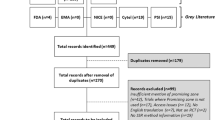Abstract
Novel statistical methods have emerged in recent medical literature, which clinicians must understand to properly appraise and integrate evidence into their practice. Some of these key concepts include win ratios, restricted mean survival time, responder analyses, and standardized mean difference. This article offers guidance to busy clinicians on the comprehension and practical applicability of the results to patients. Win ratios provide an alternative method to analyze composite outcomes by prioritizing individual components of the composite; prioritization of the outcomes should be evidence-based, pre-specified, and patient-centered. Restricted mean survival time presents a method to analyze Kaplan–Meier curves when assumptions required for Cox proportional hazards analysis are not met. As it only considers outcomes that occur within a specific timeframe, the duration of follow-up must be appropriately defined and based on prior epidemiologic and mechanistic evidence. Researchers can analyze continuous outcomes with responder analyses, in which participants are dichotomized into “responders” or “non-responders.” While clinicians and patients may more easily grasp outcomes analyzed in this way, they should be aware of the loss of information and resulting imprecision, as well as potential to manipulate data presentation. When meta-analyzing continuous outcomes, point estimates can be converted to standardized mean differences to facilitate the combination of data utilizing various outcome measures. However, clinicians may find it challenging to grasp the clinical meaningfulness of a standardized mean difference, and may benefit from converting it to well-known outcomes. By providing the background knowledge of these statistical methods, along with practical applicability, benefits, and inevitable limitations, this article aims to provide clinicians with an approach to appraise the literature and apply the results in clinical practice.





Similar content being viewed by others
References
Redfors B, Gregson J, Crowley A et al. The win ratio approach for composite endpoints: practical guidance based on previous experience. Eur Heart J. 2020;41(46):4391–9.
Pocock SJ, Ariti CA, Collier TJ, Wang D. The win ratio: a new approach to the analysis of composite endpoints in clinical trials based on clinical priorities. Eur Heart J. 2011;33(2):176–82.
Wentz RJ, Ward JH, Hernandez AF et al. Angiotensin-neprilysin inhibition in patients with mildly reduced or preserved ejection fraction and worsening heart failure. J Am Coll Cardiol. 2023;82(1):1–12.
Biegus J, Voors AA, Collins SP et al. Impact of empagliflozin on decongestion in acute heart failure: the Empulse trial. Eur Heart J. 2022;44(1):41–50.
Ferreira JP, Jhund PS, Duarte K et al. Use of the win ratio in cardiovascular trials. JACC Heart Fail. 2020;8(6):441–50.
Ajufo E, Nayak A, Mehra MR. Fallacies of using the win ratio in cardiovascular trials. JACC Basic Transl Sci. 2023;8(6):720–7.
Guimarães HP, Lopes RD, de Barros e Silva PGM et al. Rivaroxaban in patients with atrial fibrillation and a bioprosthetic mitral valve. N Engl J Med. 2020;383(22):2117–26.
Gregson J, Sharples L, Stone GW, Burman C-F, Öhrn F, Pocock S. Nonproportional hazards for time-to-event outcomes in clinical trials. Journal of the American College of Cardiology. 2019;74(16):2102–12.
Hasegawa T, Misawa S, Nakagawa S et al. Restricted mean survival time as a summary measure of time to event outcome. Pharmaceutical Statistics. 2020;19(4):436–53.
Kim DH, Uno H, Wei L-J. Restricted mean survival time as a measure to interpret clinical trial results. JAMA Cardiology. 2017;2(11):1179-80.
Han K, Jung I. Restricted mean survival time for survival analysis: a quick guide for clinical researchers. Korean Journal of Radiology. 2022;23(5):495-99.
Connolly SJ, Karthikeyan G, Ntsekhe M et al. Rivaroxaban in rheumatic heart disease–associated atrial fibrillation. New England Journal of Medicine. 2022;387(11):978–88.
Snapinn SM, Jiang Q. Responder analyses and the assessment of a clinically relevant treatment effect. Trials. 2007;8(1).
Cook CE, Bejarano G, Reneker J, Vigotsky AD, Riddle DL. Responder analyses: a methodological mess. J Orthop Sports Phys Ther. 2023;1–9.
Duru G, Fantino B. The clinical relevance of changes in the Montgomery–Asberg Depression rating scale using the minimum clinically important difference approach. Curr Med Res Opin. 2008;24(5):1329–35.
Dean RL, Hurducas C, Hawton K et al. Ketamine and other glutamate receptor modulators for depression in adults with unipolar major depressive disorder. Cochrane Database Syst Rev. 2021;2021(11).
Fedorov V, Mannino F, Zhang R. Consequences of dichotomization. Pharm Stat. 2009;8(1):50–61.
Murad MH, Wang Z, Chu H, Lin L. When continuous outcomes are measured using different scales: guide for meta-analysis and interpretation. BMJ. 2019; 364: k4817
Cohen J. Statistical power analysis for the behavioral sciences. Hillsdale, NJ: L. Erlbaum Associates; 1988.
Cochrane Handbook for Systematic Reviews of interventions [Internet]. [cited 2023 Jul 15]. Available from: https://training.cochrane.org/handbook/current
Author information
Authors and Affiliations
Corresponding author
Ethics declarations
Conflict of Interest:
The authors declare that they do not have a conflict of interest.
Additional information
Publisher's Note
Springer Nature remains neutral with regard to jurisdictional claims in published maps and institutional affiliations.
Rights and permissions
Springer Nature or its licensor (e.g. a society or other partner) holds exclusive rights to this article under a publishing agreement with the author(s) or other rightsholder(s); author self-archiving of the accepted manuscript version of this article is solely governed by the terms of such publishing agreement and applicable law.
About this article
Cite this article
Lane, M., Miao, T. & Turgeon, R.D. Clinician’s Approach to Advanced Statistical Methods: Win Ratios, Restricted Mean Survival Time, Responder Analyses, and Standardized Mean Differences. J GEN INTERN MED 39, 1196–1203 (2024). https://doi.org/10.1007/s11606-023-08582-w
Received:
Accepted:
Published:
Issue Date:
DOI: https://doi.org/10.1007/s11606-023-08582-w




